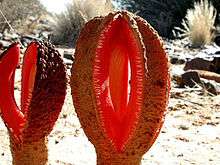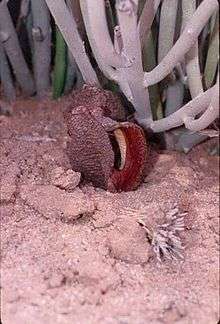Hydnora africana
Hydnora africana is an achlorophyllous plant in the family Hydnoraceae, native to southern Africa that is parasitic on the roots of members of the family Euphorbiaceae.[1] It is also called jakkalskos or jackal food.[2] The genus name comes from the Greek word hydnon, which translates to "truffle," and the specific epithet africana means to be from Africa.[3] Molecular data has suggested that Hydnoraceae is a "basal angiosperm" solidifying its place among the more primitive flowering plants.[1] Hydnoraceae are the only angiosperms known to have no leaves or scales and are considered obligate parasites, completely dependent on their hosts to survive.[4] The plant grows underground, except for a fleshy flower that emerges above ground and emits an odor of feces to attract its natural pollinators, dung beetles and carrion beetles.[5] The vegetative body of the plants has been reduced to only consisting of roots and flowers.[6] The flowers act as temporary traps, retaining the beetles that enter long enough for them to pick up pollen.[7]
| Hydnora africana | |
|---|---|
 | |
| Hydnora africana flowers, Karasburg Constituency, Namibia, 2002 | |
| Scientific classification | |
| Kingdom: | Plantae |
| Clade: | Tracheophytes |
| Clade: | Angiosperms |
| Clade: | Magnoliids |
| Order: | Piperales |
| Family: | Aristolochiaceae |
| Subfamily: | Hydnoroideae |
| Genus: | Hydnora |
| Species: | H. africana |
| Binomial name | |
| Hydnora africana | |
Description

Morphology
The vegetative parts of this plant are more similar in appearance to a fungus than a plant.[8] These plants do not have chlorophyll and do not perform photosynthesis. They obtain their nutrients entirely from a host plant, such as a species of Euphorbia. The plant is composed of thick succulent roots with no stems and the flower develops on surfaces of the host's roots. The flower is used as a temporary trap in order to facilitate pollination.[9] Hydnora africana has an enzyme which allows it to dissolve some of the roots of its host plants in order to attach to them. Hydnora africana attaches to the roots of the host and takes some of the nutrients that it makes from photosynthesis.[10] The flower has a succulent and thick texture, the portion that appears above ground is tubular with three openings.[11] There are three structures botanically named perianth segments which can be compared to sepals that unite at the top of the flower.[11] It has a fleshy peachy-orange flower that emerges from the ground after a heavy rainfall.[3] The flower is where the perianth segments join and a short tube is present. The anterior portion of the tube there are yellowish-orange structures extend into the tube, these are the anther groups.[12] These groups of anthers are held in bunches and are used as the flowers stamens. The anther groups are arranged into a triangle so that a gap forms between their pits and the beetles will proceed to fall down onto the stigma of the parasitic plant.[12] The basal portion of the flower there is a cavity that houses the white ovules that will mature into seeds.[12] Insects that pollinate the flowers do so by burying themselves in the sepals of the flowers through the very strong fibres that hold the sepals together. After the insects have been in the flowers for a couple of days, the flower emerges and opens releasing the insects to spread the pollen to other flowers in the area.[10]
Fruit
H. africana produces a fruit that grows underground, taking up to two years to ripen fully. The fruit is similar in taste and texture to a potato. Among other uses, it is used for tanning and preserving fishnets, because it is an astringent.[3] Each fruit produces about twenty thousand seeds. The fruit may be up to about eight centimetres in diameter.[13] Animals using the fruit as a source of food include, but are not limited to, birds, smaller animals, jackals, porcupines, and moles.
Smell
Hydnora africana has a very strong and unpleasant smell. This smell is generated from the osmophores, which is a white spongy area on the inner surface of the tepals that eventually change colour to grey. Osmophores were first called "bait bodies" by Harmes.[14] Burger et al. concluded that the odour is made up of dimethyl disulphide and dimethyl trisulfide. These odors are also found in dead-horse arum, Helicodiceros muscivorus.[14]
Reproduction
Seeds from Hydnora africana were brought back to the United States from Africa and planted in pots of Euphorbia. A flower of Hydnora africana first appeared five and a half years after the initial sowing.[15]
Ethnobotany
Rhizome extracts of Hydnora africana are used as an anti-dysenteric treatment in South Africa.[16]
References
- "Hydnora africana". Botanical Society of America. 24 February 2020.
- "Hydnora africana Thunb". SA National Biodiversity Institute. Retrieved 5 May 2020.
- Voigt, Werner. "Hydnora africana". Missing or empty
|url=(help) - "Parasitic Plants". Old Dominion University. Retrieved 1 March 2020.
- Waser, Nickoloas Merritt; Ollerton, Jeff, eds. (2006). "Table 6.1: Angiosperms with rewardless flowers". Plant-Pollinator Interactions: From Specialization to Generalization. University of Chicago Press. pp. 126–9. ISBN 978-0-226-87400-5.
- "Parasitic Plants". ww2.odu.edu. Retrieved 1 March 2020.
- "BSA Parasitic Plant Pages- Hydnora africana". Botanical Society of America. Archived from the original on 4 June 2013. Retrieved 9 June 2013.
- "Hydnora africana - Useful Tropical Plants". tropical.theferns.info. Retrieved 1 March 2020.
- "Hydnora Africana – KSPRI". Retrieved 1 March 2020.
- Campbell, Dana. "Jackal Food (Hydnora africana)". Encyclopedia of Life. Retrieved 28 October 2014.
- "Hydnora africana". Botanical Society of America. 24 February 2020.
- "Hydnora africana". Botanical Society of America. 24 February 2020.
- "Hydnoraceae-Description". Missing or empty
|url=(help) - Bolin, Jay F. Pollination Biology Of Hydnora africana Thunb. (Hydnoraceae) In Namibia: Brood-Site Mimicry With Insect Imprisonment.
- "The Genus Hydnora". Parasitic Plants. Missing or empty
|url=(help) - Wintola, OA; Afolayan, AJ (4 September 2015). "The antibacterial, phytochemicals and antioxidants evaluation of the root extracts of Hydnora africanaThunb. used as antidysenteric in Eastern Cape Province, South Africa". BMC Complementary and Alternative Medicine. 15 (1): 307. doi:10.1186/s12906-015-0835-9. ISSN 1472-6882. PMC 4558922. PMID 26335685.
- "Hydnora africana - Useful Tropical Plants". tropical.theferns.info. Retrieved 1 March 2020.
| Wikimedia Commons has media related to Hydnora africana. |